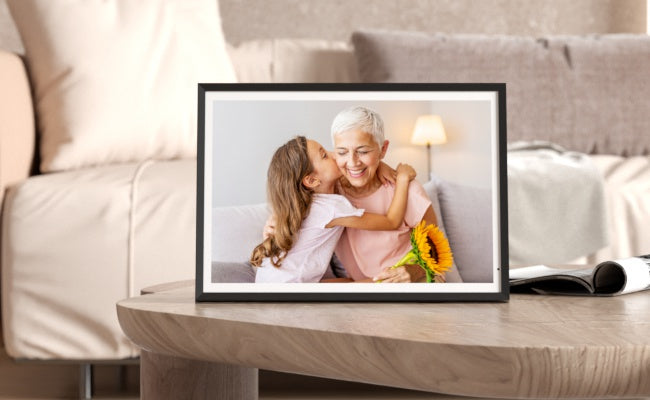Transform Your Android Device into a Stunning Digital Photo Display
Your smartphone or tablet holds thousands of precious memories, but they often remain hidden in gallery folders, rarely seen or appreciated. Converting your Android device into a dedicated photo display breathes new life into these digital treasures, allowing you to enjoy your favorite moments throughout the day.
Why Use Your Android as a Photo Frame
Traditional printed photo frames limit you to a single image, but digital solutions offer unlimited possibilities. Your Android device can cycle through hundreds or thousands of photos, displaying different memories throughout the day. Whether you're repurposing an old tablet that's gathering dust or setting up a dedicated display in your home, the flexibility of digital frames makes them increasingly popular.
The benefits extend beyond simple slideshow functionality. Modern solutions allow you to pull images from cloud storage, social media, and multiple devices, creating a centralized display of memories from your entire family. You can customize transition effects, set schedules for different photo collections, and even integrate weather information or calendars alongside your images.
Essential Features to Look For
When exploring options for displaying photos on Android, certain features distinguish exceptional solutions from basic alternatives. Cloud integration stands at the top of this list, enabling automatic syncing from services like Google Photos, Dropbox, or OneDrive. This means new photos appear on your display without manual intervention.
Customizable slideshow settings provide control over timing, transitions, and display order. Some applications offer shuffle modes, while others let you organize photos into specific albums for different times of day. Energy-saving features become crucial if you plan to run your display continuously, with options to dim the screen during certain hours or activate sleep modes.
Image quality optimization ensures your photos look their best on screen. The ideal solution automatically adjusts photos to fit your device's aspect ratio without distortion, applies subtle enhancements to improve visibility, and maintains proper orientation for both portrait and landscape images.
Setting Up Your Display
Transforming an Android device into a dedicated photo display requires some initial configuration. Start by selecting a suitable device—older tablets work wonderfully for this purpose, giving them a second life as permanent displays. Position the device where you'll enjoy viewing it most: kitchen counters, bedside tables, and office desks are popular choices.
Power management becomes important for always-on displays. Consider keeping your device plugged in continuously, but enable battery optimization features to prevent long-term battery degradation. Many dedicated applications include kiosk modes that prevent accidental touches from interrupting your slideshow, particularly useful if you have children or pets.
For wall mounting, various tablet stands and wall mounts accommodate different device sizes. Some people prefer adjustable stands that allow angle changes throughout the day, while others opt for flush wall mounts that create a more integrated appearance.
Free vs Premium Options
The marketplace offers both free and paid solutions, each with distinct advantages. Free applications typically provide core slideshow functionality with basic customization options. They're perfect for testing the concept before committing to a more feature-rich solution. However, free versions often include advertisements or limit the number of photos you can display simultaneously.
Premium options remove these restrictions while adding advanced features like facial recognition to prioritize photos of specific people, location-based organization, or integration with multiple cloud services. Some premium solutions also offer cross-device syncing, allowing you to control your display remotely or mirror the same photo collection across multiple devices in different rooms.
My Experience Creating a Kitchen Display
Last year, I repurposed a seven-inch Android tablet that had been replaced by a newer model. Rather than letting it sit unused in a drawer, I transformed it into a kitchen photo display that has genuinely enhanced our daily life. I mounted it on the counter where we prepare meals, angled slightly upward for comfortable viewing while cooking.
The setup process took about thirty minutes, including selecting which photo albums to display and configuring the rotation schedule. I connected it to our family's shared photo library, which automatically updates whenever someone adds new pictures. The real magic happened during the first week, when I noticed family members pausing to smile at forgotten moments that appeared on screen—a hiking trip from two years ago, our daughter's first day of school, spontaneous moments that would have remained buried in cloud storage.
One unexpected benefit was how it sparked conversations during meals. Photos would prompt stories we'd forgotten to share, connecting past experiences with present moments. Guests particularly enjoy it, often asking about the locations and events they see displayed.
Optimizing Photo Collections
Not every photo in your library works well for continuous display. Action shots with motion blur, duplicate images, and screenshots clutter your slideshow without adding value. Taking time to curate your photo collection significantly improves the viewing experience.
Create dedicated albums specifically for your display, including only your best and most meaningful images. Consider seasonal collections that you can rotate throughout the year—summer vacation photos during warm months, holiday gatherings in December, spring blooms as winter ends. This rotation keeps the display fresh and contextually relevant.
Image resolution matters more than you might expect. While your device will display lower-resolution photos, high-quality images look noticeably sharper and more vibrant. When building your display collection, prioritize photos taken with good cameras in favorable lighting conditions.
Creative Display Ideas
Beyond basic slideshows, creative implementations can serve multiple purposes. A display in your entryway can welcome family members home with cherished memories while also showing the weather forecast and calendar events. Bedroom displays might show calming landscape photography in the evening and family photos during waking hours.
Some users create themed displays for specific occasions—birthday celebrations showing photos of the birthday person throughout the years, anniversary displays featuring relationship milestones, or memorial collections honoring loved ones. The flexibility of digital displays makes these temporary configurations easy to implement and change as needed.
For families with young children, displaying recent photos helps kids see themselves and recognize family members. Educational applications can display letters, numbers, or vocabulary words alongside family photos, combining entertainment with learning.
Technical Considerations
Screen burn-in presents a legitimate concern for devices running continuous displays. OLED screens are particularly susceptible, though modern Android devices include protections against this issue. Enable screen savers that shift content position slightly, vary your photo collection regularly, and consider using the built-in pixel shifting features available on many devices.
Storage management becomes relevant when displaying thousands of photos. Cloud-based solutions address this by streaming images rather than storing everything locally, though this requires consistent internet connectivity. If you prefer local storage for offline reliability, regularly review and remove photos you no longer wish to display to maintain available space.
Network connectivity affects performance depending on your chosen solution. Cloud-based applications need stable Wi-Fi connections to load new photos and sync updates. Position your display within good range of your router, or consider Wi-Fi extenders if necessary.
Making the Most of Your Digital Display
Transforming an Android device into a photo display offers a meaningful way to celebrate your memories while giving new purpose to existing technology. The constant presence of rotating photos creates ambient awareness of the moments that matter most, subtly enriching your daily environment.
Start simple with a basic setup and expand features as you discover what works for your household. Experiment with different locations, photo collections, and display schedules until you find the perfect configuration. The versatility of Android devices means you can continuously refine and improve your setup without additional hardware investments.
Whether you're using a current device temporarily or dedicating an older tablet permanently, digital photo displays represent a practical fusion of technology and sentimentality that enhances any living space.






